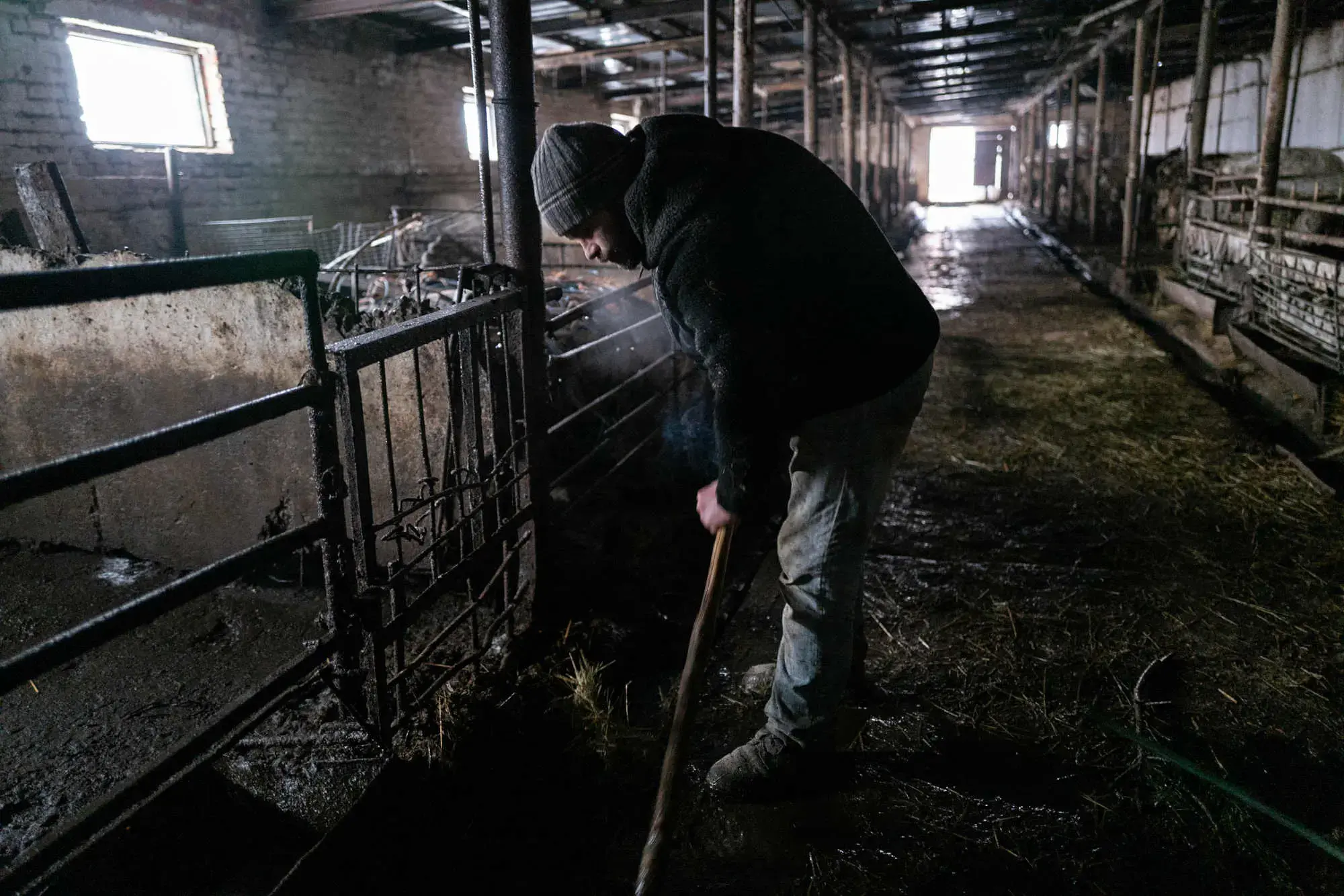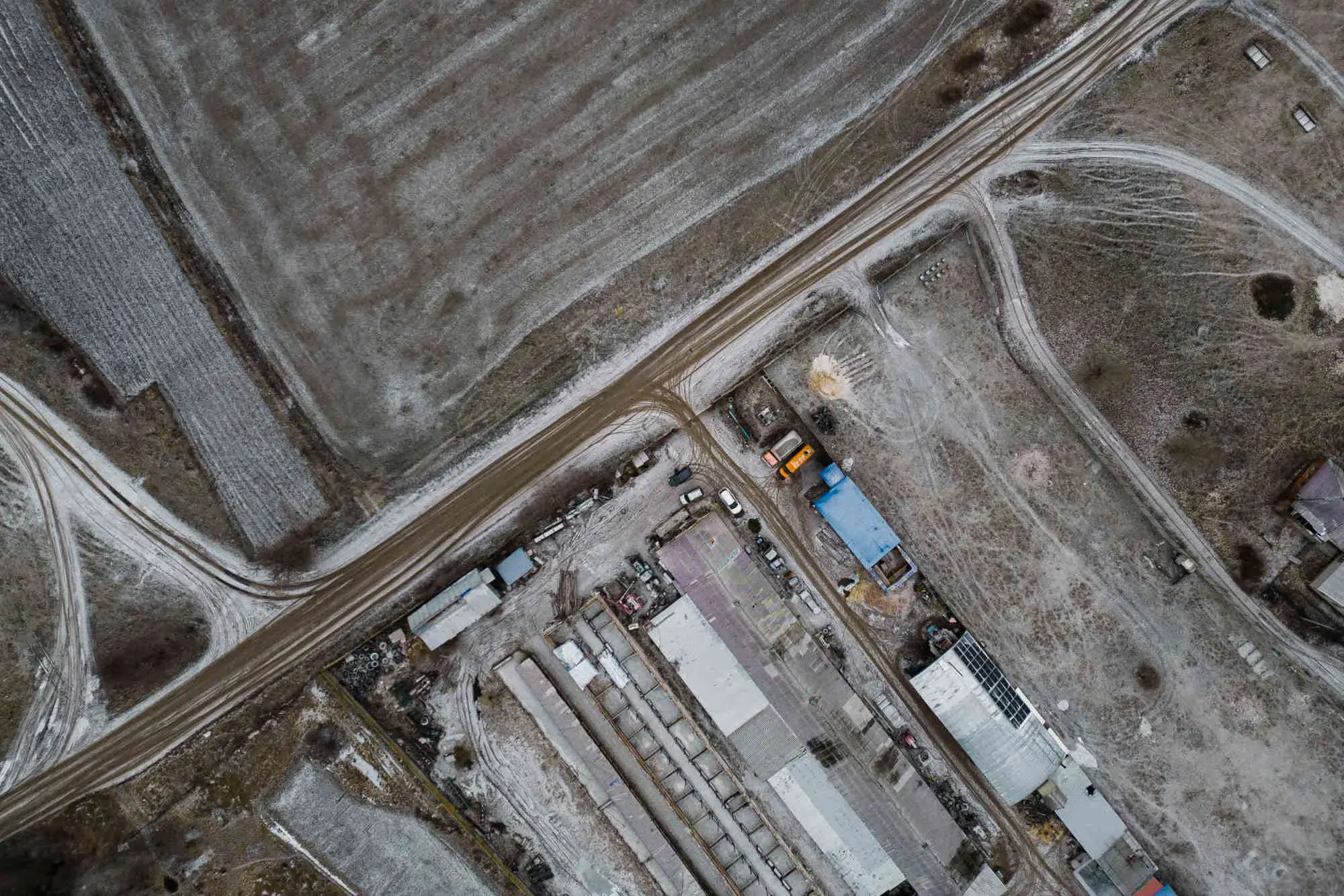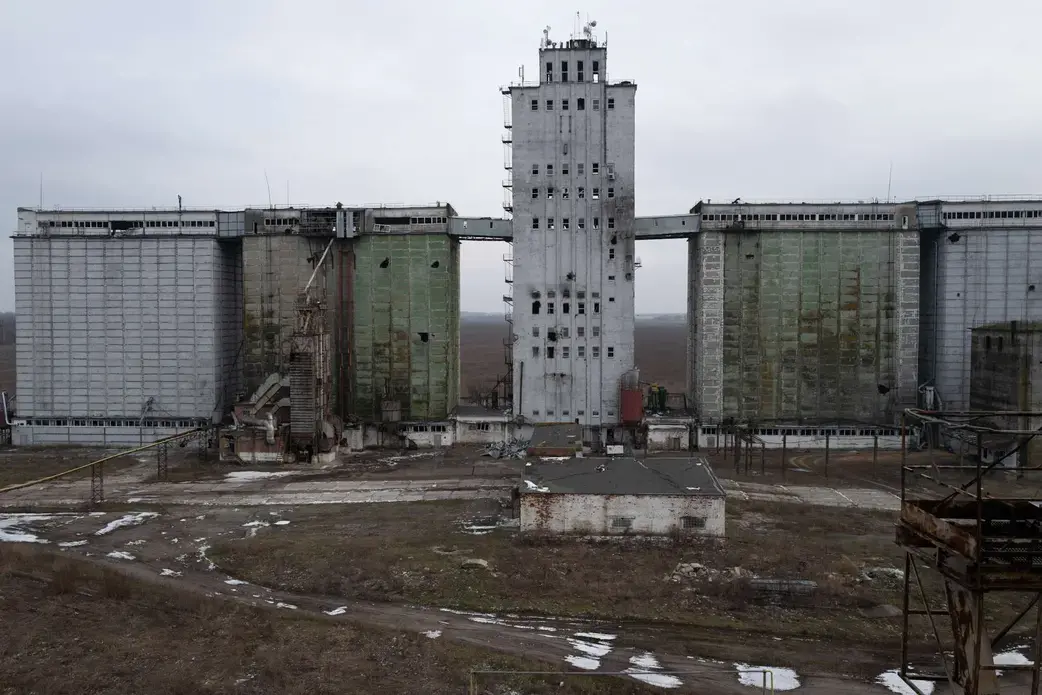
On-the-ground reporting confirms a landmark study: Extensive wartime damage to Ukraine’s crucial agricultural sector.
It was the spring of 2022 when rockets began to land in Lyonid Lysachenko’s wheat fields in Eastern Ukraine.
The first rockets landed “a few weeks after the invasion began,” he said, crunching across one of his snow-crusted fields nearly a year later, in early February. He stopped and hitched up the collar of his jacket against the biting wind, then pointed east. “Their positions were only a few kilometers away at one point. This whole area was within range.”
Lysachenko has been farming this 1,100-acre-plus plot of land for more than three decades, and, at 70, his crushing farmer’s handshake has lost none of its strength. When he spoke of the war, though, his broad shoulders sagged a little and his smile faded.

As a nonprofit journalism organization, we depend on your support to fund coverage of global conflicts. Help us continue funding the hard costs of in-depth coverage of the Ukraine invasion—including travel, hostile environment safety training, and the increased security expenses that arise from reporting in war zones.
The same day that Lysachenko’s farm was first hit, his neighbor’s was too. The neighbor’s grain was also destroyed. Lysachenko estimated the loss at more than 1,000 tons “because the rocket landed right in the middle of his warehouse.”
Soon after, another Russian rocket struck the large grain elevator at the center of Lysachenko’s property. No one was injured, but the building was obliterated, along with the grain inside. The financial damage was immense.
“I lost about 200 tons, if you count everything — corn, wheat,” Lysachenko said, adding that the grain losses were up to about $41,000. Repairing the damage was expensive, too. All told, Lysachenko estimated it cost him around $200,000 to fix his storehouse and elevator. And even that was not the full extent of the damage. A large portion of Lysachenko’s most recent harvest had to be left in the fields to rot — the fighting came on so fast that he didn’t have time to collect and clean the grain.
“There are big losses here,” he said.






Lysachenko’s experiences are not isolated. In September 2022, a report by the Yale School of Public Health’s Human Research Lab highlighted the scope of the war’s effect on Ukraine’s grain industry. The findings of the study, which combined high-resolution satellite imagery with machine learning and open-source intelligence, were stark.
More than 3.3 million tons of crop storage capacity — greater than 5 percent of Ukraine’s total — had been damaged, destroyed, or was within Russian-controlled territory. One of the chief authors of the report, Nathaniel Raymond, told Undark that the figures outlined in the report are conservative. Even with sophisticated technology and a comprehensive methodology, it was impossible to capture and assess all of the damage.
The destruction of grain silos and crops is a financial disaster for Ukrainian farmers. According to figures published by the Kyiv School of Economics and Ukraine’s Ministry of Agrarian Policy and Food, the country suffered $11.2 billion in crop losses in the first eight months of the war, and expects to absorb $3 billion in losses in 2023 winter crops. But the repercussions now stretch far beyond the borders of Ukraine to some of the world’s most impoverished countries, which depend on Ukrainian grain for food and livestock feed. The World Food Program — the world’s largest provider of humanitarian aid — sources much of its wheat from Ukraine. By May 2022, just a few months after the invasion began, the price of wheat in Africa had already increased by 45 percent, according to the African Development Bank.
Over the coming year, if Ukraine’s grain exports remain curtailed by the war, according to the Food and Agriculture Organization of the United Nations, “the global number of undernourished people could increase by 8 to 13 million people.”
Since the collapse of the Soviet Union in 1991, Ukraine has become a major player in the global trade of wheat, corn, barley, and sunflower seeds and oil. In the early 1990s, Ukraine accounted for a small fraction of global wheat exports; in the 2021-2022 growing season that number had climbed to nearly 10 percent. That same season, Ukraine was the world’s largest producer of sunflower seeds, the fourth largest producer of barley, and sixth and seventh for corn and wheat respectively, according to the U.S. Department of Agriculture. And the agricultural sector is a central pillar of Ukraine’s economy — in 2021, agricultural products accounted for 41 percent of the country’s total exports, and the agricultural sector employed 14 percent of its workforce.
As Ukraine has risen in the global grain market, it has played a key role in developing and food-insecure countries. In 2021, Ukraine’s largest wheat export customers were Egypt, Indonesia, Turkey, Pakistan, and Bangladesh. Humanitarian organizations also rely heavily on Ukrainian crops for the food aid provided to some of the world’s most famine-affected countries.
The country suffered $11.2 billion in crop losses in the first eight months of the war, and expects to absorb $3 billion in losses in 2023 winter crops.
To understand how these grain supply chains may be affected by the war, the authors of the 2022 Yale report identified and analyzed 1,399 crop storage sites across the country.
“Part of the significance of the report was the methodological innovation that went into it,” said Nathaniel Raymond, the executive director of Yale’s Humanitarian Research Lab. Raymond and his team worked with the U.S. Department of Energy’s Oak Ridge National Laboratories, using the Summit supercomputer — normally used to model thermonuclear explosions in stars — to assess the extent of physical damage to crop storage silos and warehouses. The team compared images of the buildings taken both before and after the Russian invasion. Over the course of nearly eight weeks, the researchers built a machine-learning algorithm to identify grain silos and to look for any changes.
Training the algorithm to identify which buildings were storage silos was not a simple task. Their most reliable data set was only updated until 2019, Raymond told Undark. “Basically we had three years in which silos could have been built or destroyed that were not reflected,” he said, and the team also needed a control against the grain elevator data set “to make sure that it was correct.”
After identifying the sites where silos were located, the team then had to train the algorithm to spot distinctive patterns of physical damage caused by artillery, rockets, or guided missiles. Once the algorithm churned through the imagery and identified sites that had clearly been damaged after the Russian invasion, the Yale team used open-source intelligence from local media and social media to cross-check.
The approach had limitations. A lot of these farms were falling apart “in a way that had no relationship to war damage,” Raymond said. Was a roof of a storehouse damaged from shelling, or was it simply in disrepair? The ambiguity forced the team to track instances where it could “only be the burn and damage pattern of a munitions strike,” he said.
Using this approach, the team identified 75 storage sites that had been damaged by Russian shelling or guided missiles between late February and August 2022, equating to about 3.3 million tons of damaged storage, more than the capacity of around 24,000 standard rail cars full of wheat.
Raymond, who has worked on multiple projects that used satellite imagery to aid in the identification of human rights abuses, said that the report, and planned updates, could help inform potential war crime prosecutions against Russia. “We represent one piece of forensic inquiry into the question,” he said. “At the end of the day, there are four or five other pieces that a prosecutor would need to bring it to charge.” But is it doable? “Yes, it is,” Raymond said.
The Yale team's work matches up with the on-the-ground experiences of Dmytro Dobroshtan, the director of Novaagro, a Ukrainian agricultural company that operates six silo complexes in the Kharkiv region — one of the most war-affected areas of the country. Novaagro silos have been damaged or destroyed in three separate locations across eastern Ukraine since the start of the war. In the best cases, damage from shelling or rockets means reduced capacity — a silo full of holes cannot hold grain. In the worst cases, full silos that sustained direct hits were obliterated, and thousands of tons of grain were set alight and destroyed.
Before the war, the total storage capacity was about 350,000 tons, Dobroshtan said. Now, by his estimate, that capacity has been nearly halved. “We will restore something” he added, “but 40 percent will most likely be lost.”

At one of Dobroshtan’s facilities in Kharkiv Oblast, two metal silos, one holding corn and another sunflower seeds, were smashed apart by a Russian rocket. One of the silos held over 3,300 tons of sunflower seeds. “The fire took place for three-and-a-half months and we could not cope with it,” he said. As he explained, sunflower seeds can’t be extinguished by water, because the oil in the seeds is flammable.
In order to quench the blaze, firefighters in special heat suits had to climb inside the silo and empty the seeds through holes in the sides. Nearly five months later, the grain still smoldered in low, ashy piles on the snow-covered plains.
In the second silo, around 7,100 tons of corn burned completely, Dobroshtan said. And that was the loss from only these two silos.
As the Yale authors noted, not all major damage is visible from satellite or aerial imagery. Outside, a concrete elevator might appear visually intact, Dobroshtan said, but the power systems inside are burned out. With no functioning systems to move the grain within the elevator, the entire building is useless.
Not far from Lyonid Lysachenko’s farm, in Mala Rohan, Slovina Lubova’s grain storehouses were also destroyed by Russian rockets. It happened last year on her birthday, March 26, she said, sitting in her kitchen in January 2023. There are still holes in her ceiling from shrapnel, and scars on the front door from where it was kicked open by Russian troops, who she said occupied her house for several weeks.
Lubova’s farm is typical for eastern Ukraine — she grows wheat and sunflower, but also raises cows. Now, alongside half-dismantled tractors and farm equipment, her property is scattered with the remnants of Russian cluster munitions.
When the rockets began to land on March 26, 2022, Lubova’s warehouses were reduced to twisted metal and charred concrete. “The whole roof blew apart from the explosions,” she said. “Fourteen rockets landed here in one day, they were falling like rain.”






Lubova lost more than 60 tons of wheat that had already been cleaned and was waiting to be sold. For a farm that only produces about 330 tons of wheat each season, it was a huge financial hit. Adding to the loss: On March 25, she had finalized plans for the wheat to be transported to market, just a day before her warehouse was hit.
Even before Lubova harvested the grain that was later destroyed in her warehouse, she had lost much of her crop while it was still growing in the fields. “This year I didn’t sell anything, because most of it burned in the fields” — nearly 50 acres worth, she said. “Everything we salvaged was stored in these warehouses, and now that’s gone too.”
The effects of the war are reverberating throughout the global grain market. Within the first year of Russia’s invasion, “Four million tons of grains and oilseeds have been destroyed or stolen, and storage for 9.4 million tons of agricultural products has been damaged or destroyed,” according to a recent assessment by the Center for Strategic and International Studies. According to the same assessment, the total value of damages to Ukraine’s agriculture sector exceeds $6.6 billion. The total value of losses — the foregone agriculture-based revenue due to these damages — is more than $34.25 billion.
In his introduction to the 2022 Global Report on Food Crises, U.N. Secretary-General António Guterres wrote: “The war in Ukraine is supercharging a three-dimensional crisis — food, energy, and finance.” The war, he continued, had “devastating impacts on the world’s most vulnerable people, countries, and economies.”
“This year I didn’t sell anything, because most of it burned in the fields."
Slovina Lubova
By August of 2022, Ukraine’s grain exports had already decreased by more than 46 percent compared to the previous year, according to statistics released by Ukraine’s Ministry of Agriculture. This drop was likely the combined result of multiple factors: farmland made unusable due to mine and ordnance contamination, damaged grain silos limiting storage capacity, destroyed grain stock, and Russian shipping blockades of Ukrainian ports. In early February 2023, a report by the U.N. Food and Agriculture Organization estimated that the amount of available land for planting winter wheat had shrunk by 40 percent compared to the previous year.
Dobroshtan confirms that the amount of grain from the next season will be lower than usual. “The problem isn’t just that there’s nowhere to store it,” Dobroshtan said. “In our region, about 30 percent of winter wheat has been sown.” He adds that in areas near the front, no one sowed anything, which will “have its consequences.” And this year’s harvest is expected to be about half what it was last year.





Even if arable land remains free from Russian control, future harvests may still be at risk. A recent study by Ukraine’s Institute for Soil Science and Agrochemistry Research suggests that the war has already degraded the soil quality in some of the country’s most fertile areas. The damage could cut the potential grain harvest by nearly a third of its pre-war output, the Soil Institute’s director, Sviatoslav Baliuk, told Reuters in March.
Early on in the war, Russian naval blockades of large Ukrainian ports added further barriers between Ukrainian grain and the market. On July 22, 2022, a joint agreement between Turkey, Russia, and Ukraine aimed to provide safe passage for the export of grain from three key Ukrainian ports. Known as the Black Sea Grain Initiative, the agreement allowed some Ukrainian grain exports by sea to resume, although at significantly reduced levels than prior to the war.
As a result of the sharp drop in global grain supply, almost as soon as Russia’s invasion of Ukraine began, global food prices began to skyrocket.
A recent report by the World Food Program’s East Africa division reported that the cost of imported wheat in the region has increased by nearly 60 percent since the conflict in Ukraine began in February of last year. The report also noted that the price of an average basket of food for one family has increased by about 55 percent over the past 12 months.
Standing in one of his newly repaired grain warehouses on his farm near Mala Rohan, Lyonid Lysachenko scooped a handful of corn from a high pile, and let the kernels slowly fall through his weathered fingers. Because it was winter, there wouldn’t be more planting until March or April. But the warm winds of spring may bring with them the renewed sounds of war, too. A new Russian offensive is predicted, and Lysachenko’s fields, dormant under a thin crust of snow, may once again become a battlefield. But there is nothing else to do but continue on.
“We are slowly selling now, we deliver here locally,” he said. Soon, he hopes, “we will deliver to Odessa, and will enter the European markets.”

As he stepped out of the darkness of his warehouse, into the biting winter wind, Lysachenko stood a little straighter. He said he knows the cost that he and others will pay if his work cannot continue.
“If you think about the damage caused here as a whole, it’s appalling,” he said, pointing back towards the warehouses. “Now we are working, looking for sales, ways, partners to sell corn, wheat, sunflower seed. We are engaged in realization, in improving the situation. We work. We do what we have to do.”
Update: Because of a miscommunication during an interview, a previous version of this story suggested that the Summit supercomputer is typically used to model blasts from nuclear weapons. The Summit supercomputer is used to model thermonuclear explosions in stars. The story also suggested that as of August 2022, nearly 5 percent Ukraine’s crop storage capacity had been damaged, destroyed, or was within Russian-controlled territory; in fact more than 5 percent had been damaged or destroyed. For both errors, the story has been updated to reflect the correct information.
Note: Numerous interviews for this story were conducted with the help of Yulia Zubova, who aided with translation during conversations with Ukrainian speakers. She also provided supplemental reporting.

































